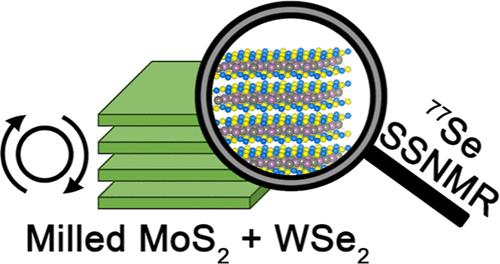通过硒-77 固态核磁共振波谱对合金和纳米颗粒过渡金属二钴化物的结构研究
IF 7
2区 材料科学
Q2 CHEMISTRY, PHYSICAL
引用次数: 0
摘要
层状过渡金属二钙化物(TMDCs),如 MoS2、MoSe2 和 WSe2,是一种原子薄半导体,其光物理性质可通过改变其成分或形态进行调整,因此正受到广泛研究。有人提出用机械化学处理的方法来获得 Mo1-xWxSySe2-y 系列(x = 0-1;y = 0-2)的合金 TMDC。然而,要阐明机械化学处理后在原子尺度上发生的化学变化可能具有挑战性,因为产物通常是无定形或微晶的。为了应对这一挑战,我们结合粉末 X 射线衍射、拉曼光谱、漫反射光谱、77Se 固态核磁共振 (SSNMR) 光谱和平面波密度泛函理论 (DFT) 计算,对 TMDC 混合和合金化进行了探究。结果表明,研磨材料和反应气氛的性质是限制不良氧化物副产物形成的关键因素。我们展示了使用卡尔-普塞尔-梅博姆-吉尔采集 (CPMG) 脉冲序列、魔角旋光 (MAS) 和 MAS 动态核极化的不同组合采集 77Se SSNMR 光谱。SSNMR 与其他表征方法的结合清楚地表明,高能冲击球磨诱导了 Mo1-xWxSySe2-y 族中 Mo、W 和瑀原子的分子级合金化。包括投影仪增强波 DFT 计算在内的量规计算得出了准确的 77Se 化学位移 (CS) 张量成分。77Se SSNMR 光谱还被用于研究插层乙二胺的 WSe2 纳米晶体的结构。与块状 WSe2 相比,插层 WSe2 纳米晶体表现出更正的各向同性 77Se CS,但是 77Se CS 的各向异性是相同的,这证实了 WSe2 层与块状 WSe2 层具有相似的结构。本文章由计算机程序翻译,如有差异,请以英文原文为准。

Structural Studies of Alloyed and Nanoparticle Transition Metal Dichalcogenides by Selenium-77 Solid-State Nuclear Magnetic Resonance Spectroscopy
Layered transition metal dichalcogenides (TMDCs) such as MoS2, MoSe2, and WSe2 are under intense investigation because they are atomically thin semiconductors with photophysical properties that can be tuned by changing their composition or morphology. Mechanochemical processing has been proposed as a method to obtain alloyed TMDCs in the series Mo1–xWxSySe2–y (x = 0–1; y = 0–2). However, elucidating the chemical transformations occurring at the atomic scale following mechanochemical processing can be challenging because the products are often amorphous or microcrystalline. To address this challenge, we probe TMDC mixing and alloying by using a combination of powder X-ray diffraction, Raman spectroscopy, diffuse reflectance spectroscopy, 77Se solid-state nuclear magnetic resonance (SSNMR) spectroscopy, and planewave density functional theory (DFT) calculations. The nature of the milling material and reaction atmosphere are shown to be essential factors in limiting the formation of undesired oxide byproducts. We demonstrate acquisition of 77Se SSNMR spectra using different combinations of Carr-Purcell Meiboom-Gill acquisition (CPMG) pulse sequences, magic angle spinning (MAS), and MAS dynamic nuclear polarization. The combination of SSNMR with the other characterization methods clearly demonstrates that high energy impact ball milling induces molecular level alloying of Mo, W and chalcogen atoms in the family Mo1–xWxSySe2–y. Gauge including projector augmented wave DFT calculations yield accurate 77Se chemical shift (CS) tensor components. 77Se SSNMR spectroscopy was also applied to study the structure of WSe2 nanocrystals intercalated with ethylenediamine. The intercalated WSe2 nanocrystals exhibit a more positive isotropic 77Se CS as compared to bulk WSe2, however, the 77Se CS anisotropy is the same, confirming the WSe2 layers have a similar structure as in their bulk counterparts.
求助全文
通过发布文献求助,成功后即可免费获取论文全文。
去求助
来源期刊

Chemistry of Materials
工程技术-材料科学:综合
CiteScore
14.10
自引率
5.80%
发文量
929
审稿时长
1.5 months
期刊介绍:
The journal Chemistry of Materials focuses on publishing original research at the intersection of materials science and chemistry. The studies published in the journal involve chemistry as a prominent component and explore topics such as the design, synthesis, characterization, processing, understanding, and application of functional or potentially functional materials. The journal covers various areas of interest, including inorganic and organic solid-state chemistry, nanomaterials, biomaterials, thin films and polymers, and composite/hybrid materials. The journal particularly seeks papers that highlight the creation or development of innovative materials with novel optical, electrical, magnetic, catalytic, or mechanical properties. It is essential that manuscripts on these topics have a primary focus on the chemistry of materials and represent a significant advancement compared to prior research. Before external reviews are sought, submitted manuscripts undergo a review process by a minimum of two editors to ensure their appropriateness for the journal and the presence of sufficient evidence of a significant advance that will be of broad interest to the materials chemistry community.
 求助内容:
求助内容: 应助结果提醒方式:
应助结果提醒方式:


